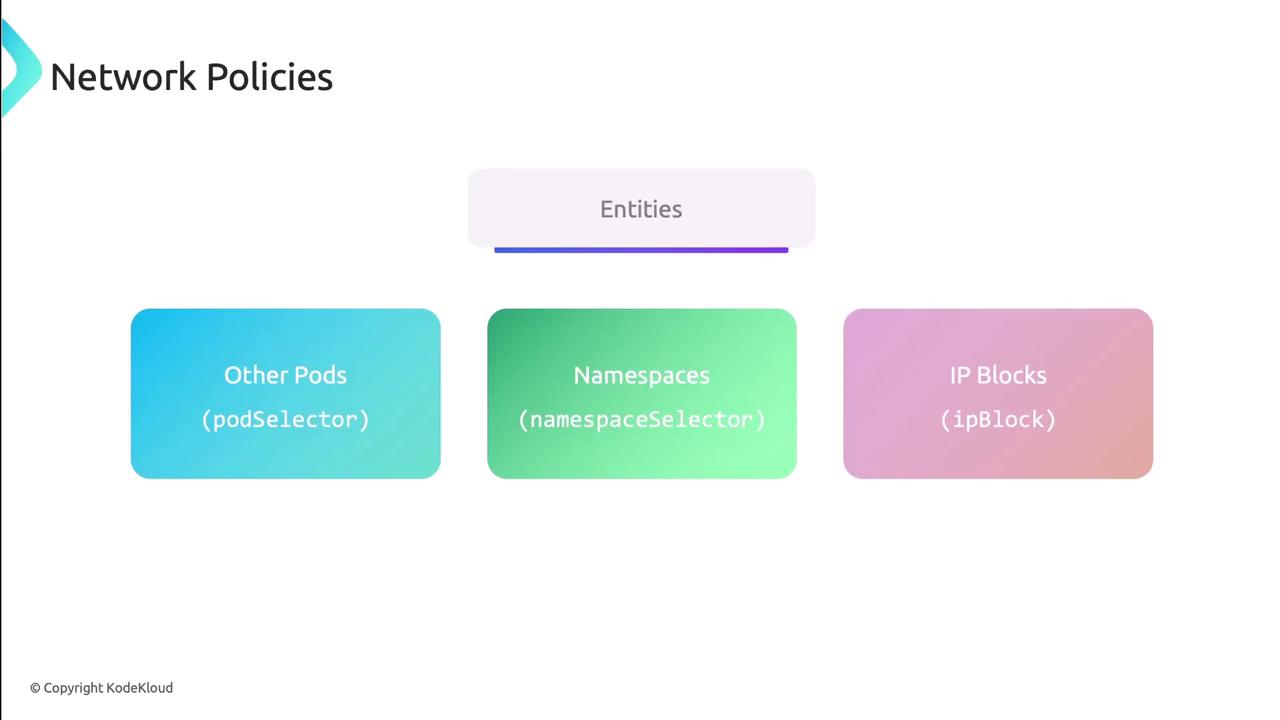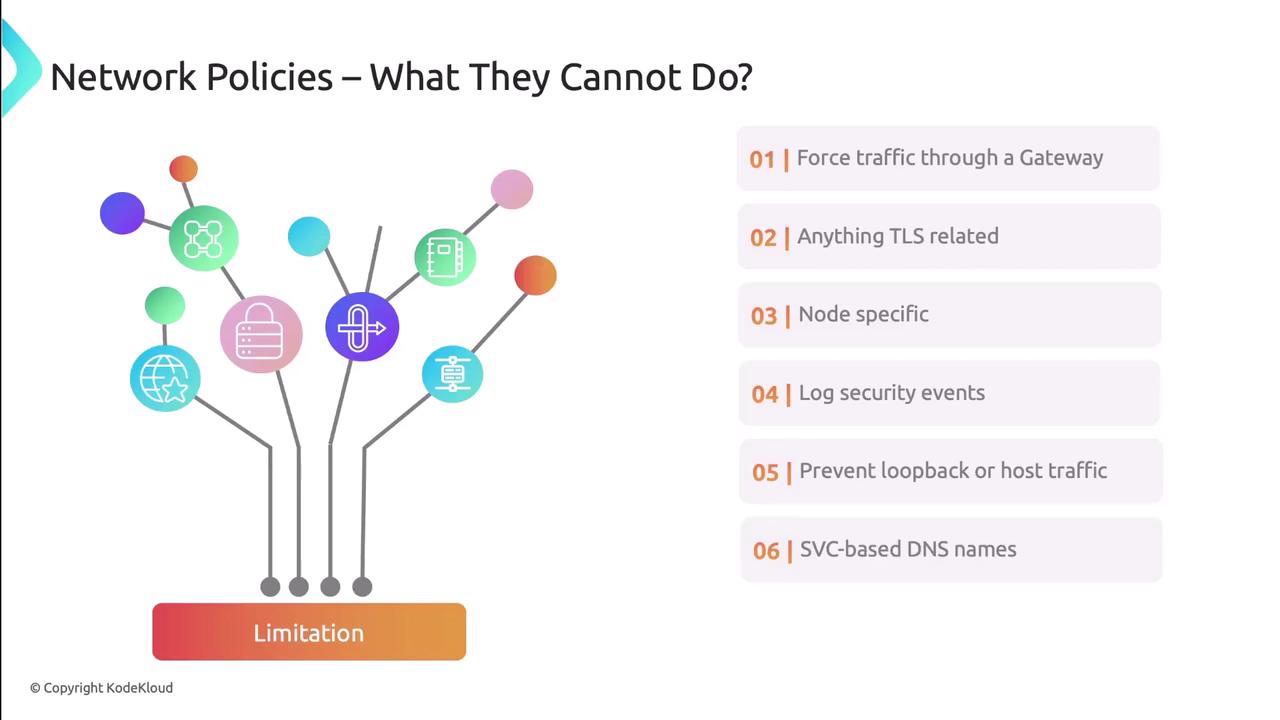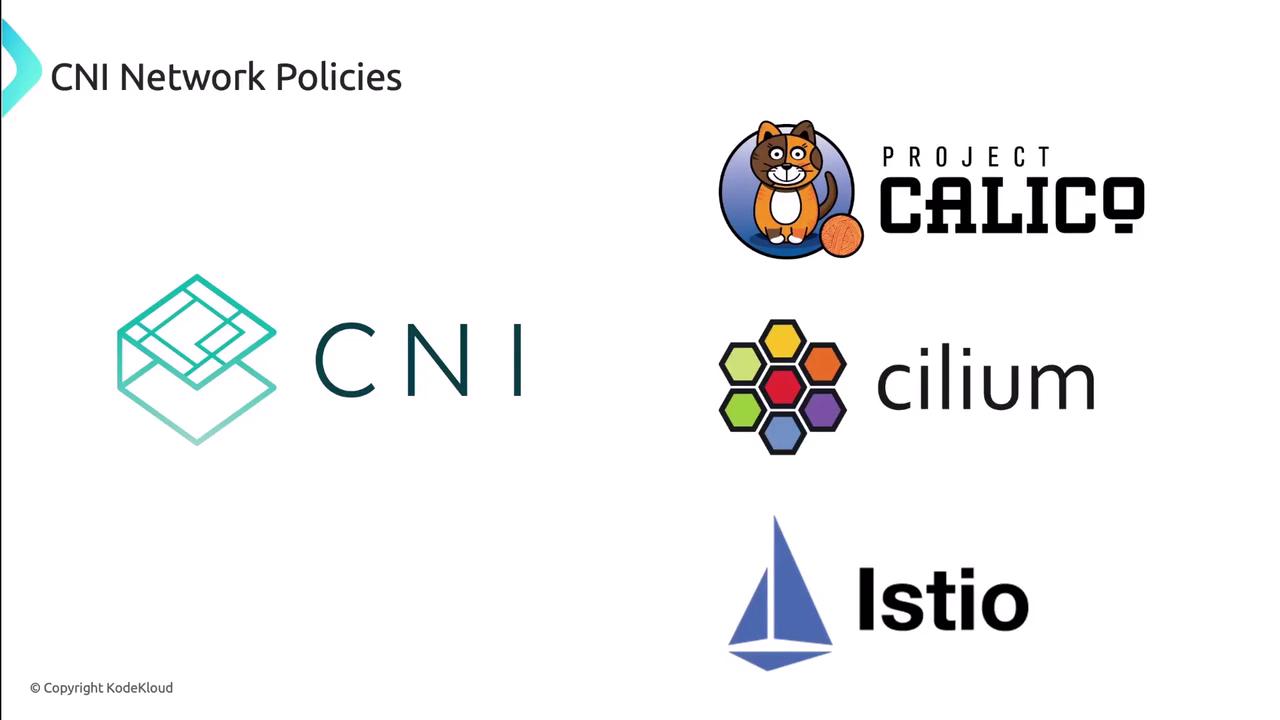Kubernetes Networking Deep Dive
Container Network InterfaceCNI
Network Policies Overview
Kubernetes pods communicate freely by default, which simplifies development but poses risks in production. Network Policies close this gap by defining fine-grained rules for pod-to-pod, namespace, and external traffic. Think of them as traffic signs in your cluster that explicitly allow or deny connections.

Key Entity Types
Network Policies match traffic based on three entities:
| Entity Type | Selector Key | Description |
|---|---|---|
| Other Pods | podSelector | Select pods by labels |
| Namespaces | namespaceSelector | Select namespaces by labels |
| IP Blocks | ipBlock | Specify CIDR ranges and exclusions |

Defining a NetworkPolicy
A NetworkPolicy is a namespaced resource that applies to pods matching podSelector. You must also declare policyTypes (Ingress, Egress, or both) and the corresponding rules:
apiVersion: networking.k8s.io/v1
kind: NetworkPolicy
metadata:
name: test-network-policy
namespace: default
spec:
podSelector:
matchLabels:
app: app1
policyTypes:
- Ingress
- Egress
ingress:
- from:
- namespaceSelector:
matchLabels:
team: frontend
- podSelector:
matchLabels:
app: app2
egress:
- to:
- ipBlock:
cidr: 10.0.0.0/24
Entity Selectors and IP Blocks
Use label selectors for pods and namespaces:
# Namespace selector with expressions
namespaceSelector:
matchExpressions:
- key: environment
operator: In
values: ["prod", "staging"]
# Pod selector with labels
podSelector:
matchLabels:
app: frontend
For IP-based rules, you can exclude subnets:
ipBlock:
cidr: 172.17.0.0/16
except:
- 172.17.1.0/24
Layer 4 Ports and Protocols
Control ports and protocols (requires Kubernetes v1.25+ for port ranges):
- to:
- podSelector:
matchLabels:
app: database
ports:
- port: 5432
protocol: TCP
endPort: 5434
port: Single port or starting port of a rangeprotocol: TCP or UDP (defaults to TCP)endPort: End of port range (optional)
Default Policies
By default, all ingress and egress traffic is allowed. You can enforce a “deny all” or “allow all” baseline by using an empty podSelector: {}.
Note
An empty podSelector: {} matches every pod in the namespace.
Ingress Defaults
# Deny all ingress
apiVersion: networking.k8s.io/v1
kind: NetworkPolicy
metadata:
name: default-deny-ingress
namespace: default
spec:
podSelector: {}
policyTypes:
- Ingress
---
# Allow all ingress
apiVersion: networking.k8s.io/v1
kind: NetworkPolicy
metadata:
name: default-allow-ingress
namespace: default
spec:
podSelector: {}
policyTypes:
- Ingress
ingress:
- {}
Egress Defaults
# Deny all egress
apiVersion: networking.k8s.io/v1
kind: NetworkPolicy
metadata:
name: default-deny-egress
namespace: default
spec:
podSelector: {}
policyTypes:
- Egress
---
# Allow all egress
apiVersion: networking.k8s.io/v1
kind: NetworkPolicy
metadata:
name: default-allow-egress
namespace: default
spec:
podSelector: {}
policyTypes:
- Egress
egress:
- {}
You may combine Ingress and Egress in a single policy or separate them.
Benefits of Network Policies
- Granular security controls by workload
- Isolation in multi-tenant clusters
- Compliance with GDPR, HIPAA, PCI DSS
- Reduced attack surface by blocking unused paths
- Consistent enforcement across applications

Limitations
Network Policies operate at layers 3 & 4 and have some constraints:
- Cannot enforce a common gateway (service mesh can)
- No built-in TLS termination or deep packet inspection
- Cannot restrict host-level traffic or localhost loops
- No native allow/deny event logging
- Label-based only—cannot target Service objects
- No Layer 7 (HTTP/gRPC) filtering

CNI-Specific Enhancements
Several CNI providers extend Kubernetes Network Policies with advanced capabilities:
| CNI Plugin | Advanced Features |
|---|---|
| Project Calico | Global policies, BGP routing, NetworkSets |
| Cilium | Layer 7 HTTP/gRPC filtering, eBPF datapath, Hubble insights |
| Istio | Service mesh policies, mTLS, ingress/egress gateways |

Next Steps
You now understand native Kubernetes Network Policies—how to control ingress and egress by pod, namespace, IP block, ports, and ranges. In the next lesson, we’ll apply these concepts in a real-world scenario.
References
Watch Video
Watch video content